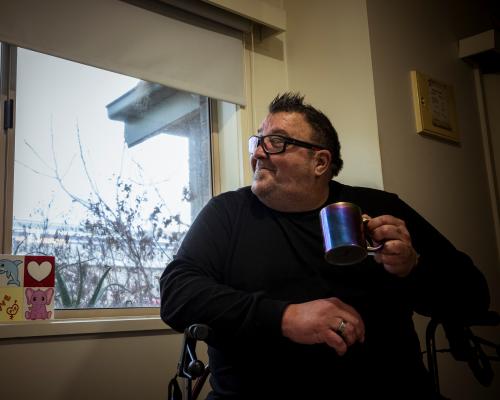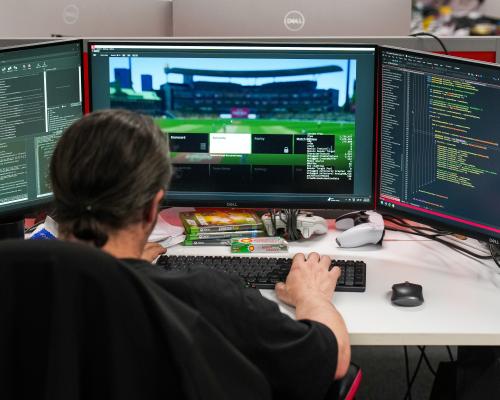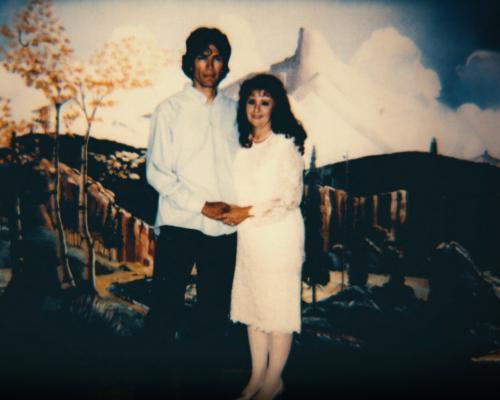
If you ask Rodney, he will tell you that life is for living. He’s been to the edge of it – homeless, depressed, stuck in a broken system. He has spent years on the street.
The signs of it show – the 57-year-old is missing teeth, uses a cane to walk, his body is failing.
But out of the big, burly former rugby player comes a voice soft with gratitude. A voice that trembles when it recounts getting beaten up on the streets by men coming out of pubs, a voice that lifts when he talks about how to win a ruck. A voice that knows if it wasn’t for a rare housing program, he would still be out there.
“Nine years I was on the street,” Rodney says.
“I’d resigned myself to the fact that it’s going to be years before I can get a public housing spot.
“I was on the Gold Coast. I was at Byron. I went to Canberra. It just got to the point where I couldn’t find anywhere safe, where I felt safe.”
Sitting in his kitchen, he has stories to tell. He’s got stories about how he played professional rugby here and in Ireland, getting 11 concussions on the field, being knocked out four times.
He’s got stories about how he would “be hit” with the smelling salts and get straight back on the ground. About one time he was bleeding from his ears and they still sent him back on. How now he forgets things.
He’s got stories about how, after that, he went into security – working for Kings of Leon and Park Life and Big Day Out. How he saw a face in the street one day and was hit by a flood of memories from when he was 13. How a friend had to tell him he wasn’t a victim but a survivor.
Rodney was part of a growing cohort – those who have been persistently homeless – sleeping on a couch or in a car, tucked into doorways, for more than a total of seven months over a 24-month period.
Sign up: AU Breaking News email
This cohort has grown from 29,500 in 2018–19 to 36,600 in 2022–23, data from the Australian Institute of Health and Welfare shows.
And this cohort would be described by social workers as complex. Some have psychosocial disabilities, cognitive impairment or compounding issues. Many of them have fled violent homes. Of all clients experiencing persistent homelessness in 2022–23, more than two in five (42%) were women and children affected by family and domestic violence.
Often they cycle through the system – in and out of temporary accommodation, in and out of overstretched hospitals. Running out of options and burning out from the daily exhaustion of working out where to sleep night after night.
Homelessness advocates say there is an easy fix – a program that is having success overseas. Getting people into homes, but more importantly helping them to stay there.
Julia Derham works on Journey to Social Inclusion – a unique housing program she co-manages that has a 90% success rate.
Since 2009, the program has been run by Sacred Heart, but is now being managed by a consortium of providers. Social workers spend three years with rough sleepers, getting them into homes and helping rehabilitate them into society, with 640 people placed into homes since it began.
It’s a rare success story from the frontlines.
“It’s mind-boggling for me, that perspective of you give someone a house and everything’s sorted,” she says of other programs.
There are eligibility rules, however. People have had to be rough sleeping for 12 months or have had multiple episodes of homelessness over three years. They also have to be on the Victorian Housing register – in the line of 55,024 applicants for social housing.
If they are successful, a person is referred to the J2SI program through frontline services. Then a social worker will make contact with them in the next 90 days – to make sure they’re interested and open to the program. Then they are tied to a case manager for the next three years.
And the challenges come early. If someone is rough sleeping, J2SI social workers will try to refer them to emergency accommodation – but with beds in high demand it can be hard. Getting to the end of a 10-minute appointment without an exhausted client losing it can also be hard. Tracking down someone who might not own a phone or a charger can be harder again.
“Consistency is a big key part of the engagement phase – and rocking up,” Sacred Heart co-manager Eloise Torpy says. “And even if it is someone who can only handle [a meeting for] five minutes, we rock on for five minutes. That’s not a waste of time.”
The program’s distinctive three-year term is broken up into three parts: getting a person engaged with services, getting a person settled into a house and making sure a person is connected to society – referred to as “consolidation”, she says.
Some clients move into a home but sleep in their lounge room because they are not used to a bedroom. Some put mattresses in front of their doors and windows. The social workers work with them while they adjust.
Eloise tells a story. A client in his late 40s, who had become homeless when his mother died, had never had a home as an adult.
She took the client three property options, and he was so enthused talking about which one he should choose, he independently ordered their coffees himself – something she hadn’t seen him do before.
“It’s just those little things that are just such a wonderful part of being on a three-year journey with someone. He’s still successfully housed; it’s been around three years now.”
Every day in Australia, a vast amount of resources, both financial and human, are spent trying to get people housing. But advocates say the effort will be wasted until we move from an emergency response system to a prevention-focused system.
The proof is in the numbers – Finland has almost ended homelessness through a similar strategy. There has been a 68% reduction in long-term homelessness since 2007 through national strategy Housing First. Tenants are given unconditional housing and social workers help integrate them into the community, treat their mental health issues, link them with services and jobs.
The Finnish government did this by building social homes and purchasing apartments from the private market. It turned hostels and shelters that house rough sleepers for a few nights into independent apartments for people to live in.
Short-term Band-Aids became long-term solutions.
Michael Fotheringham, from the Australian Housing and Urban Research Institute, says Australia already has a Housing First approach. But there just isn’t enough housing to give, and there isn’t often help for people once they do get it.
“The basic principles of Housing First is … first you house them, then you resolve their other problems with wraparound services and supports.
“One of the traps that some services get into is they do the housing part and don’t really follow through on the wraparound services.
“That’s not Housing First. That’s just housing.”
Fotheringham says Australia mostly relies on crisis accommodation to plug holes in the severe end of the housing crisis, which only offers temporary relief.
“Two weeks, for example, is not enough time for people to actually address the range of challenges that they’re dealing with, to get themselves back on their feet.”
So if there is a housing solution that works – why isn’t it Australia’s national strategy?
“For the same reason that we’ve got a waiting list in the tens of thousands in each state,” Fotheringham says. “We don’t have enough accommodation for this. There is simply a big supply problem.”
On the other end of the line, Homelessness Australia CEO, Kate Colvin, sounds exasperated. She’s banged this drum before.
Colvin says Australia’s homelessness service system must focus on finding people more permanent housing, to end the exhausting cycle of a temporary roof over one’s head.
When he was on the street, Rodney didn’t bother with temporary accommodation; a night here or there wouldn’t help him, he says.
After he came to Melbourne, Rodney was in a swag, then a men’s shelter, then a private rental he couldn’t afford and then a mental health facility.
Then, J2SI found him his home. They set him up with furniture, a real bed, a TV, and a tricycle so he could get around. He rides to the cafe to see friends and in summer, down along the foreshore. He’s on the right medication.
In July, Rodney finished his three years in the program.
“I’m happy with where I am, and I’m more happy with who I am. I’ve kind of found myself again.
“Something’s got to change, and it’s got to change quick. And the only way we’ll get change is when state and federal governments realise the system’s broken, and there’s no use trying to stick your fingers in the pipe, because the walls are breaking.
“It has to be stripped down to bare bones and start it again.”






